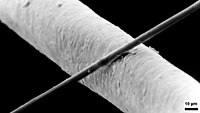
Photo from wikipedia
Abstract Carbon fiber reinforced hydroxyapatite (CF/HA) composites have been considered as a promising candidate for load-bearing bone replacement. However, high-temperature sintering decomposes HA in CF/HA composites, thereby causing oxidation damage… Click to show full abstract
Abstract Carbon fiber reinforced hydroxyapatite (CF/HA) composites have been considered as a promising candidate for load-bearing bone replacement. However, high-temperature sintering decomposes HA in CF/HA composites, thereby causing oxidation damage in carbon fibers and decreasing the mechanical properties of the composites. In this study, CF/HA composites with excellent mechanical properties and biological activities were fabricated by spark plasma sintering (SPS). The mechanical properties and microstructures of the composites under different sintering temperatures and fiber contents were systematically investigated. Oxidative damage in CF and interfacial problem between fibers and the matrices in the composites were prevented in contrast to that in CF/HA composites prepared through pressureless or hot-pressing sintering. The reinforcing effect of CF was greatly enhanced owing to the absence of oxidative damage. FTIR and XRD results indicates that the HA phases in the composites did not decompose. HA particles size prepared by SPS was smaller than the one prepared by the traditional sintering method. The addition of CF with excellent electrical and thermal conductivities reduced thermal and electrical gradients in the composites during SPS. Accordingly, CF/HA composites with a refined microstructures and improved mechanical properties were obtained. The hardness and bending strength of 0.5 wt% CF-reinforced HA composites (0.5 C F/HA) were 574.0 H V and 110.4 MPa, respectively. The fracture toughness and brittleness index of 0.5 C F/HA were 2.41 MPa m1/2 and 2.59 μm−1/2, respectively. Importantly, the fracture toughness and bending strength of 0.5 C F/HA were can match the properties of compact bones. The in vitro behaviour of the CF/HA composites for cell morphology and proliferation were evaluated using MC3T3-E1. MC3T3-E1 cultured on the composites fabricated SPS showed significantly higher attachment and proliferation rates than those cultured on composites prepared through pressureless sintering. The CF/HA prepared by SPS showed potential as load-bearing bone substitutes owing to their excellent properties.
Journal Title: Ceramics International
Year Published: 2020
Link to full text (if available)
Share on Social Media: Sign Up to like & get
recommendations!